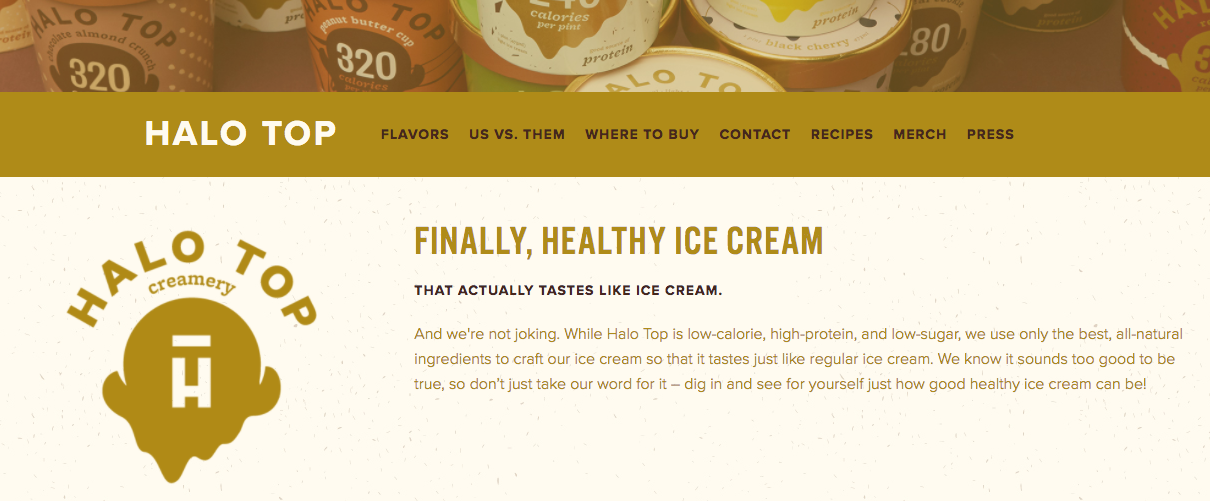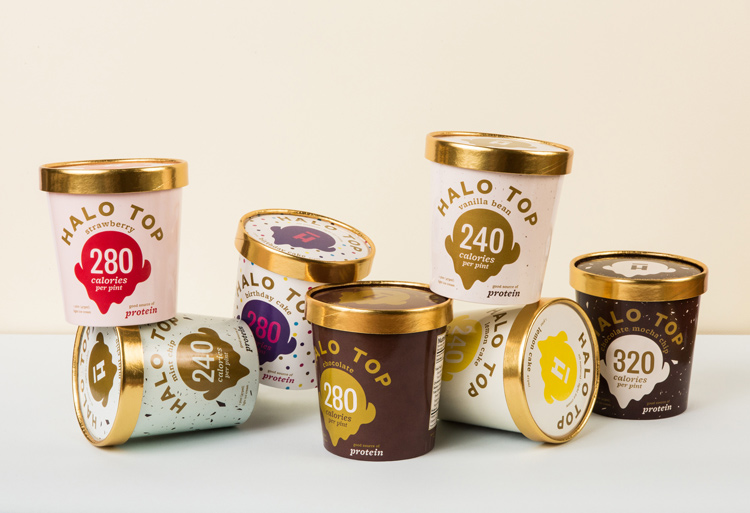Fighting Words is a column in which writers rub you the wrong way with their unpopular but well-argued opinions on fitness, health, nutrition, what have you. Got something to get off your chest? Send your pitch to tonic@vice.com.
Last week, low-calorie ice cream brand Halo Top became the #1 seller of pints in grocery stores, beating out behemoths Ben & Jerry’s and Häagen-Dazs. Each pint of the self-proclaimed “healthy ice cream” contains 240 to 360 calories, depending on the flavor, and 20 grams of protein. It’s an impressive feat, really; an entire pint of Halo Top has about the same number of calories (and half the fat) as a single, half-cup serving of Ben & Jerry’s or Häagen-Dazs.
Videos by VICE
Coaxing people to eat the whole pint is part of the brand’s marketing, in fact, with the packaging on some flavors instructing people to “save the bowl” and “stop when you get to the bottom.” To peel back the golden seal on a pint of Halo Top is to enter the “guilt-free zone,” after all; CEO Justin Woolverton went so far as to describe his product as “a lifestyle ice cream” that you can keep stocked in your freezer. The brand, which launched in 2012, saw sales of its 17 flavors grow by a staggering 2,500 percent last year and Reuters exclusively reported on Monday that its parent company is allegedly exploring a sale with a valuation as high as $2 billion.
To slash calories and attempt to preserve taste and texture of regular ice cream, Halo Top cut out some of the fat and sugar and added the natural no-calorie sweetener stevia (theirs is organic), a sugar alcohol called erythritol, and prebiotic fibers from plants like chicory root. Halo Top is essentially light ice cream, which has existed for ages, but it’s spun as a “healthy” option since it’s not only low in calories and sugar, but is high in protein (if you eat the whole pint, that is), uses “all-natural” ingredients, and has the aforementioned fiber.
Thing is, the phrase “healthy ice cream” is an oxymoron, as New York University professor of nutrition, food studies, and public health Marion Nestle put it to Fortune. Ice cream is not healthy, no matter how many organic and natural ingredients—or how little fat and sugar—it contains. Healthy foods are those that are well-rounded; “foods that provide not just protein, but vitamins, minerals, antioxidants, and fiber,” Keri Gans, a registered dietitian in New York City, tells Tonic. In other words, foods that provide a lot of nutritional bang for their caloric buck. Halo Top would be better off saying that it makes healthier ice cream.
Watch more on VICELAND:
Food labels like “good source of protein” make products sound more nutritious to the buyer; it’s known as the health halo effect (extra poignant given this particular product’s name). But despite the protein marketing blitz in recent years, most people get plenty of it, Gans says. If you’ve been told you need more, however, you can get it in other foods that are way more nutritious, like chicken or chickpeas. “A dessert is something we eat after a meal that is hopefully well-balanced. I would expect that you were getting protein elsewhere in your meal,” she says. Protein shouldn’t be a motivation to eat dessert, let alone a reason to consume a pint of ice cream in one sitting.
Some people might say, but the pint’s only 300 calories, come on!! And it’s true, that’s a very small number for a dessert. Still, you’d be using up calories on something that isn’t nutritious and may not even satisfy your craving for ice cream (more on that later). If a person needs, say, 1,800 calories a day to maintain or lose weight, a pint of light ice cream could get wedged in there, but it could easily put them over the edge or just take up valuable space. “For one person it could become excess calories, for another person it could fit right into their diet plan of 1,800 calories a day, but are they getting optimal nutrition?” Gans says. “We want our calories to count.” Occasionally eating a pint of Halo Top isn’t going to affect you all that much, but there are some people who have a pint every single night because they think it’s healthy.
More importantly, Gans says the mindset that prioritizes low-calorie foods is a problem. “People feel ‘because it’s less calories that means I can eat more,’” she says, but “there are portion sizes for a reason—and there is a portion size to this ice cream. It’s a half a cup. If you want ice cream, eat a serving of ice cream. If you’re concerned about the calories and you’re trying a low-calorie ice cream, then stick to the serving of that,” Gans says. “Otherwise it defeats the purpose and you end up consuming the same amount of calories you would have consumed if you ate a single serving of regular ice cream.” Which probably would have tasted better.
When reached for comment, Woolverton did call the product a “healthy alternative” to ice cream, still, Halo Top’s homepage uses the phrase “healthy ice cream” twice. “Halo Top contains fewer calories, less sugar, and more protein than full-fat ice cream. Of course it’s a healthy alternative to ice cream. To claim otherwise is bizarre,” he told Tonic in a statement, adding, “If I want to make a healthier bowl of jambalaya, is it okay if I remove some of the butter it’s cooked in, or use turkey sausage instead of full-fat sausage? Or do I have to make it like usual but take only two bites and put it back in the fridge?”

Woolverton told Fortune that the Food and Drug Administration’s half-cup serving size for ice cream is “flat out unrealistic” and that “people just don’t want to eat like that.” (For what it’s worth, the serving size was going to change to ⅔ of a cup in 2018, but the Trump administration announced in June that it would delay changes to the Nutrition Facts label indefinitely.)
Woolverton also pushed back on criticism of Halo Top’s healthiness in comments to Time, saying “Everybody has their own definition of healthy. For us, [it means] foods that are as unprocessed as they can be. Halo Top is something where people can eat the whole pint or a lot more than a quarter of a cup of ice cream. It can fit into their diet without breaking the calorie bank.” (Note that he likely meant half a cup, since that’s what the FDA suggests.)
Whether a food is processed isn’t the end all be all, Gans says, but in general we should be eating as few things with ingredient lists as possible. “I think people misunderstand ‘processed.’ If you think about it, almost everything we eat is processed; even roasted almonds are technically processed,” she says. “Let’s put it this way: The more fruits and vegetables, and the more 100 percent whole grains you eat, the more fish, poultry, and lean beef—the closer things are to their original state, you can’t deny that that will be good for you,” she says. Ice cream can be made with very few ingredients, though even then “that doesn’t mean you should eat unlimited amounts,” she says.
But, really, Halo Top is not ice cream; it is “ice cream” in quotations. In the words of Jezebel‘s Bobby Finger, it is dessert substitute. That Americans are buying up a “healthy” “lifestyle” dessert shouldn’t be surprising: Halo Top’s popularity is a symptom of our concurrent food guilt and orthorexia, or an obsession with clean eating. Many people feel the need to justify eating things they’d otherwise feel guilty about by citing some alleged health benefit, even if that benefit is an elaborate lie.
There’s also some implicit food moralization going on. In a release, the company says Halo Top is “ice cream people can actually feel good about eating”; by that logic, people must feel bad about eating regular ice cream. Which they do, and that’s a problem. It’s sad that we still need to say this in 2017, but you’re not “good” for shunning sugar or fat or “bad” for eating them; eating clean doesn’t make you a good person. “Nobody should feel guilty about eating ice cream—you should sit down and eat a serving of ice cream if you want and enjoy it,” Gans says. “We should be enjoying food, and I think too many people have lost touch with that.”
She adds: The words food and guilt “shouldn’t be in the same sentence. There’s a lot of things in life you might want to feel guilty about—eating should not be one of them.” Woolverton did not comment on the idea that calling Halo Top “guilt-free” implies that full-fat ice cream is guilt-ridden, but he took issue with the recommendation to follow the serving size. “Telling people to simply eat ‘a serving’ of ice cream is so unrealistic for most people that even the FDA recently changed the serving size of ice cream from 1/4 cup (four servings per pint) to 2/3 cup (three servings per pint),” he said (again citing a quarter cup instead of half a cup, and not acknowledging that the FDA changes have been put on hold).
The healthism of Halo Top puts it under the same umbrella as zucchini “noodles” and avocado “pudding.” These concoctions appeal to people who otherwise might not eat pasta or dessert, or who would, but would hate themselves for it. Instead of eating the thing we want to eat in a portion that is reasonable, we substitute something that is likely to disappoint our stomachs and our brains despite sometimes even gorging on it. And ironically, such faux foods often make people eat more because they tell themselves they’ve “saved” calories, or they’re simply still hungry afterward. Case in point: research has linked low- and no-calorie sweeteners to weight gain, not loss. Studies in mice suggest that the brain isn’t fooled: It still wants the calories it expects after tasting something sweet.
Gans says that if you truly crave something, sometimes it’s better to have the real thing. “If somebody really wants ice cream and they have something that is not quite tasting like ice cream to them, does that make them still want the ice cream? Possibly,” she says. “It’s like my patient who wants a piece of chocolate and they’re snacking on a piece of fruit instead. I’m sorry, that piece of fruit is not going to satisfy your craving for chocolate. What I would say is have a small piece of chocolate; small being the key word here.”
All of this raises the question: Do we need ice cream to be “healthy” to allow ourselves to eat it? It’s possible that the closest thing we’ll ever get to “healthy ice cream” is someone eating a serving, enjoying it, and not beating themselves up over it. If you struggle with self-control and don’t want to keep a half-gallon in your freezer, trust me, I feel you. You might consider the mini ice cream cups at the bottom of the freezer case or going out for a cone—your brain and your stomach would love that.
Read This Next: The Unhealthy Side of Wellness
More
From VICE
-

Mightiest Mark Dragapult -

(Photo by Michael Buckner/Variety via Getty Images) -

Screenshot: Warner Bros.

